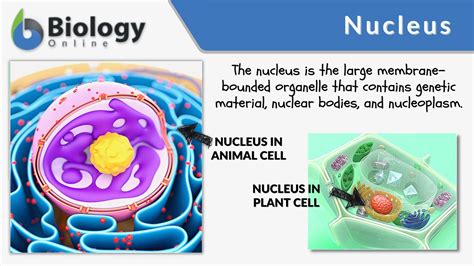

The Nucleus of a Cell: The Epicenter of Cellular Command
Introduction
The nucleus, a dynamic organelle located at the heart of eukaryotic cells, is the control center responsible for orchestrating cellular functions. This microscopic marvel is packed with genetic information, steers cellular processes, and maintains the harmonious operation of the cell.

Anatomy and Structure of the Nucleus
Nuclear Envelope
The nucleus is enclosed by a double membrane called the nuclear envelope, which acts as a protective barrier while regulating the flow of materials into and out of the nucleus. The nuclear envelope contains nuclear pores, which facilitate the exchange of molecules between the nucleus and the cytoplasm.
Key Fact: The nuclear envelope is studded with approximately 4,000 nuclear pores per square micrometer.
Nucleolus
Within the nucleus resides the nucleolus, a prominent structure responsible for ribosome biogenesis. The nucleolus is not enclosed by a membrane, allowing direct interaction with the surrounding nuclear components.
Figure 1: Ultrastructure of the nucleus, showcasing the nuclear envelope, nucleolus, and chromatin fibers. (Image source: Science Direct)
Chromosomes and Chromatin
The nucleus houses the cell’s genetic material, organized into structures called chromosomes. Chromosomes consist of tightly coiled DNA molecules and associated proteins known as histones. When the cell is not dividing, chromosomes appear as loose, thread-like structures called chromatin.
Functions of the Nucleus
Genetic Repository
The nucleus serves as the primary repository of genetic information, containing the cell’s complete set of DNA. This genetic blueprint directs cellular processes, including protein synthesis, cell growth, and reproduction.
Statistic: Human somatic cells contain approximately 6 billion base pairs of DNA organized into 46 chromosomes.
Gene Expression Control
The nucleus is the command center for gene expression, the process by which genetic information is translated into functional proteins. Genes, specific regions of DNA, are transcribed into messenger RNA (mRNA) and translated into proteins by ribosomes.
Cellular Communication
The nucleus maintains communication with other cellular compartments, including the cytoplasm and organelles. Nuclear proteins, transcripts, and other molecules are transported to specific cellular locations to regulate cellular processes.
Significance of the Nucleus
Cell Division
The nucleus plays a crucial role in cell division, ensuring the faithful transmission of genetic information to daughter cells. During mitosis and meiosis, chromosomes are duplicated, condensed, and separated to ensure the equal distribution of genetic material.
Cellular Identity
The nucleus contains the cell’s unique genetic fingerprint, contributing to the identity and specialization of different cell types within an organism.
Challenges and Controversies
Nuclear Transport
The mechanisms governing the selective transport of molecules across the nuclear envelope remain an area of active research. Understanding these mechanisms is essential for comprehending cellular communication and nuclear function.
Nuclear Organization
The three-dimensional organization of the nucleus is a complex and poorly understood aspect of nuclear biology. Researchers are exploring how nuclear organization influences gene regulation and cellular processes.
Future Trends and Applications
Gene Editing
Advances in gene editing technologies, such as CRISPR-Cas9, enable precise modifications to the genetic material within the nucleus. This approach has the potential to treat genetic diseases and improve cell-based therapies.
Nuclear Medicine
Nuclear medicine utilizes radioactive isotopes to image and diagnose diseases. By understanding the transport and metabolism of these isotopes within the nucleus, researchers can develop more targeted therapies.
Artificial Nucleus
The concept of an artificial nucleus is an emerging area of research, aiming to create synthetic structures that mimic the functions of a biological nucleus. These artificial organelles could provide new insights into cellular biology and potential therapeutic applications.
Conclusion
The nucleus, the nucleus of a cell, is an intricate and dynamic organelle that orchestrates cellular operations. Its primary functions include genetic storage, gene expression control, cellular communication, and cell division. Understanding the nucleus is fundamental to advancing our knowledge of cell biology and developing novel therapeutic approaches. As research continues, we can expect further breakthroughs in understanding the nucleus and its critical role in cellular life.










